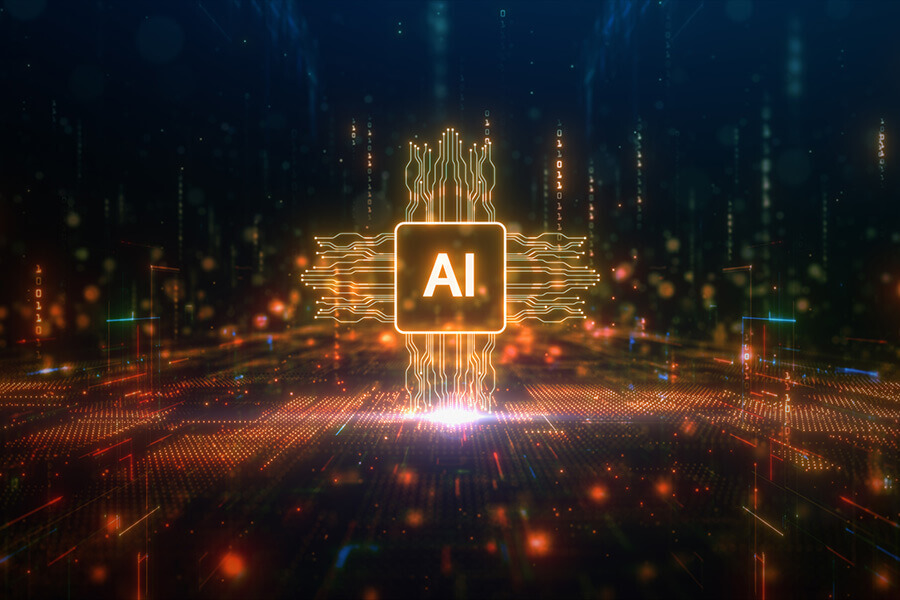AI or ML? Breaking Down the Hype to Find What You Really Need
Is your business spending on artificial intelligence but using machine learning without realizing it? The debate between Artificial Intelligence and Machine Learning often hides the truth. Many companies find it hard to distinguish these technologies, which leads to wrong strategies and lost money. With terms like artificial intelligence and machine learning in marketing, it’s easy to forget what’s important—your business goals.
This article is here to help you understand the difference. We’ll show you how to pick the right tool for your needs. We’ll guide you, whether it’s AI for complex decisions or machine learning for predictions. Learn how to avoid mistakes and make sure your tech investments pay off.
Understanding the Foundations: Artificial Intelligence and Machine Learning
To understand the AI versus ML debate, start by knowing their roles. Artificial intelligence concerns systems that act like humans, solving problems or performing tasks that require thinking. Machine learning is a part of AI that uses algorithms to improve tasks without being told how.
This section will examine what they are, how they work together, and how they impact our world.
Defining Artificial Intelligence in Today’s Context
Artificial intelligence (AI) is behind voice assistants and self-driving cars today. It’s different from old ideas because it uses lots of data to recognize images or predict what will happen next. Companies like Google use AI to improve their search results, showing how it helps make decisions.
Machine Learning: A Subset with Distinct Capabilities
So, what is Machine Learning? ML allows systems to learn from data independently. Netflix’s recommendation engine uses ML to guess what you might like. ML is a big part of AI and is especially good at finding patterns. This makes it very useful in fields like healthcare and finance.
Historical Evolution of Both Technologies
AI started in the 1950s with big dreams at the Dartmouth Conference. But early successes, like IBM’s Deep Blue in chess, had limits. The 2010s brought a new wave of big data and cloud computing, helping ML grow.
Now, AI sets the goals, and ML finds ways to achieve them. This shows how they work together, even though their operating systems are different.
AI vs ML: Key Differences That Matter for Implementation
Choosing between AI and ML starts with understanding their core purposes. AI aims to mimic human intelligence for complex tasks like natural language processing and strategic planning. Machine learning, on the other hand, improves performance through data analysis without explicit programming. These key differences and their distinct benefits guide how each technology fits with business goals.
Goal and Purpose Distinctions
Deciding when to use AI versus machine learning depends on your goals. AI is great for tasks that require autonomy, like self-driving cars or chatbots. ML is better for tasks like predictive analytics, fraud detection, or recommendation engines, as it helps find hidden patterns. Companies must decide whether they need a broad intelligence system or a data-focused learning tool.
Data Requirements and Processing Methods
Data-driven decisions require clear input needs. Machine learning needs large, labeled datasets to train models well. AI systems, however, can handle various inputs, from rule-based logic to real-time sensory data. This makes them suitable for tasks like robotics or game AI. Businesses with limited structured data prefer AI over ML.
Decision-Making Capabilities
Comparing decision-making shows a key contrast. AI systems make contextual judgments, like medical diagnosis tools, by considering patient history and treatment options. ML systems predict outcomes, like inventory management systems that forecast demand. The choice depends on whether decisions need human-like judgment or statistical precision.
Core Technical Capabilities Compared
AI and ML handle information and tasks differently. Like OpenAI’s GPT -4, AI understands natural language and can read and write like humans. On the other hand, ML is all about recognizing patterns, thanks to tools like TensorFlow.
When it comes to predictions, ML and AI have their strengths. ML uses past data to predict sales, while AI tackles complex problems like protein structure prediction. They also differ in automation. ML performs simple tasks like sorting emails, while AI handles complex tasks like self-driving cars.
| Capability | AI Example | ML Example |
| Natural language understanding | Chatbots resolving customer queries (NLP) | Keyword-based search filters |
| Pattern recognition | Medical imaging diagnostics (AI-driven) | Spam detection in email systems |
| Predictions | Stock market trend simulations | Weather forecasting models |
| Automation | Warehouse robotics adjusting to new tasks | Inventory restocking systems |
| Implementation complexity | Requires large datasets and compute power | Operates with structured input and clear parameters |
These differences show the trade-offs in technology. AI is better at understanding complex language, but ML is better at finding patterns. The choice between AI and ML depends on the task’s needs.
When to Choose Artificial Intelligence Solutions
Deciding between AI and machine learning depends on your goals and resources. AI is excellent for tasks requiring wise decisions or discovering complex patterns. Let’s examine what to consider when making this choice.
Industries and Use Cases Where AI Excels
In healthcare, AI helps doctors make accurate diagnoses. For example, IBM Watson has reduced radiology errors by 30%. In finance, AI spots fraud quickly and handles big data faster than old methods. Creative fields use AI, like OpenAI’s DALL-E, to create content faster, saving 40% of the time in media.
Resource Requirements for AI Implementation
Setting up AI needs strong hardware and cloud services. You’ll need fast GPUs and scalable cloud platforms. Also, remember to budget for ongoing data work, special skills, and upkeep. Without these, getting a good return on investment might take too long.
Challenges and Limitations of AI Approaches
AI is good at solving complex problems, but it has downsides. There are ethical issues like bias in AI and legal challenges (like GDPR). Also, fitting AI into old systems can be slow, so careful planning is needed.
| Category | Pros | Cons |
| Healthcare | Improved diagnostic accuracy | High initial R&D costs |
| Finance | Real-time fraud detection | Regulatory compliance risks |
| Creative Tech | Accelerated content creation | Dependency on training data quality |
When choosing between AI and machine learning, think about what you need. Do you need AI for smart decisions or ML for learning? Making the correct choice helps meet your business goals without wasting resources.
Machine Learning Applications: Identifying the Right Fit
Machine learning (ML) shines when recognizing patterns and making data-driven decisions. It’s different from AI because ML focuses on specific tasks. These tasks include fraud detection, predicting demand, and keeping equipment running smoothly.
For example, banks like JPMorgan Chase use machine learning (ML) to spot financial fraud. They examine spending habits to find odd patterns, allowing them to quickly catch fraud and save money without a complete AI system.
Retailers use ML to guess how much to stock. They study sales trends and seasonal changes to keep the right amount of products in store, using past data to guide their choices.
Manufacturers like Siemens use ML to predict when equipment might break down. They gather data through sensors and train models to forecast failures. Focusing on specific patterns in industrial data helps avoid costly downtime.
Netflix’s recommendation system is another excellent example of ML’s power. It uses viewer data to suggest movies and shows that fit each user’s taste. Over time, these suggestions improve, showing how ML can improve without complete AI control.
For ML to work well, you need structured data with precise patterns. Companies must ensure that their data can effectively train models. Determining whether a problem requires repetitive patterns or flexible predictions is crucial. This helps decide whether ML is the best choice over more general AI solutions.
The Talent Question: Skills Needed for AI and ML Projects
AI and ML projects need skilled engineers and teams. Companies must choose to train their teams or hire experts from places like Latin America.
Building vs. Hiring: Talent Acquisition Strategies
Training current teams can fill skill gaps but takes time and money. Hiring experts speeds up projects but costs more. Most companies use a mix, focusing on AI skills and technical know-how.
Why Latin America Is Emerging as an AI/ML Talent Hub
Brazil, Colombia, and Mexico are becoming AI/ML talent hotspots. Top schools like ITA in Brazil and Universidad de los Andes in Colombia are churning out AI/ML experts. Latin America’s affordable talent and time zone alignment with North America make it a smart choice for global teams.
| Factor | Latin America Advantage |
| Education | 200+ tech-focused universities |
| Talent Cost | 30-50% lower than U.S. rates |
| Collaboration | UTC-5 time zones align with U.S. work hours |
| Emerging Ecosystems | Startups like Rappi and Nubank drive innovation |
Hybrid methods that combine AI and machine learning are changing how businesses face tough challenges. These methods combine AI’s decision-making with ML’s predictive analytics, enabling companies to achieve results neither tech could achieve alone.
Businesses often achieve better accuracy and efficiency by using these strategies. However, they must plan carefully to manage the costs and scalability of integration.
Case Studies in Successful Integration
A top healthcare provider used ML data analysis and AI diagnostics to reduce patient wait times by 30%. A global electronics brand in retail reduced inventory errors by 25% by combining ML forecasting with AI supply chain adjustments. These stories highlight how hybrid models overcome the limitations of single systems.
Frameworks for Continuous Improvement
Good frameworks need regular checks to keep systems running well. Tools like automated feedback loops help systems improve over time. This ensures they adapt to new data.
Companies like Walmart update their AI/ML models quickly and adjust supply chain predictions in real time. Clear rules and cycle testing help manage risks and unlock the full potential of hybrid approaches.
Future Trends: How AI and ML Continue to Evolve
New trends like foundation models and reinforcement learning are changing AI and ML. McKinsey’s AI statistics show that 60% of companies focus on automation to speed up model use. This cuts development time by up to 40%.
Automation tools make training easier. This lets smaller teams use advanced systems without needing deep technical skills.
NLP advancements are changing how we understand language. Transformer models now analyze sentiment across languages with 95% accuracy. OpenAI uses these to improve chatbots and customer service.
IBM and Microsoft’s explainable AI tools provide insights into decisions, building trust in healthcare and finance.
Edge computing and hybrid AI-ML systems combine hardware and software. NVIDIA’s Orin chips help with real-time processing for self-driving cars.
Gartner predicts that the use of foundation models will grow 300% by 2026. To prepare for this future, focus on adaptable strategies now.
Conclusion: Making the Right Technology Choice for Your Business Needs
Choosing between AI and ML depends on aligning technology with business goals. The comparison of AI and ML shows key differences in scope and application. AI is excellent for complex tasks like autonomous systems, while ML is better for finding patterns in data for predictions.
Start by defining the problem. Ask if the task needs autonomous reasoning (AI) or predictive modeling (ML). Look at data quality and volume, as ML needs structured datasets. Also, consider team expertise and budget.
This guide helps simplify the selection process, avoiding common mistakes like prioritizing trends over needs or ignoring maintenance costs. For example, healthcare might use ML for diagnostics, while retail uses AI for pricing.
Deciding which to choose requires balancing technical feasibility with organizational readiness. First, focus on solving problems. The goal is to match technology to strategy, not just follow current software trends. Use this guide to ensure that every investment aligns with long-term goals.







